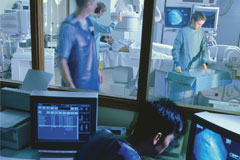Intersystem’s TrakCare™ software is a Web-based, patient-centric healthcare information system used by leading healthcare organizations around the world. It is comprised of a comprehensive portfolio of application modules, including patient.
Healthcare organizations in 25 countries are making breakthroughs in patient care with TrakCare, a unified healthcare information system that enables coordinated care within a hospital or across care settings throughout a region — facilitating a seamless patient journey.
Electronic Patient Record (EPR)
The EPR within TrakCare is designed to capture the continuum of clinical and administrative information about a patient. The record contains patient demographics, medical history, previous admission information, previous surgery information, and obstetric history. Patient information can be captured from legacy systems linked through the TrakCare Integration Platform, or the information can be obtained directly from the full set of TrakCare applications.
To access the EPR, the patient is identified by number, or name, or from an optional favourites list if he is seen often by the clinician. The EPR provides a visual display of all information that has been collected.
The EPR includes:
Patient History
Allows healthcare professionals to view, amend, or add to the patient’s past medical, social, and family history.
Allergies and Alerts
Allows healthcare professionals to view previously recorded allergies and alerts as well as add those newly identified. In addition to notifying clinicians of potential risk to the patient, information about the nature and severity of allergic reactions is also available if it has been captured. The severity can be color-coded to provide a visual display of allergic sensitivities.
Results and Order History
Presents the results and order history of diagnostic and investigative procedures. Results can be sent from the departmental system to the EPR via the TrakCare Integration Platform. This gives healthcare professionals access to results within the EPR view. Results can be displayed in a singular or cumulative format and are presented with clinical indicators, including abnormal results, reference ranges, and criticality status where applicable. System-based highlights and icons act as alerts to abnormal as well as new results.
Diagnosis Entry
Allows the input of multiple diagnoses and diagnosis status for each patient episode, including admitting diagnosis, suspected diagnosis, final diagnosis, and discharge diagnosis. The diagnoses may be based on ICD-10 or a similar coding system.
Patient Notes Entry
Allows the clinician to enter and view patients’ conditions. Notes Entry tools include strikethrough to view modifications to notes and coded text entry, facilitating the quick entry of standard phrases and comments.
Clinical Summary History
Also referred to as discharge summary, allows the clinician to view previous discharge summaries generated for a patient. This can be viewed in text or tabular format.
Time Line
Graphically displays the patient’s EPR. It also allows healthcare professionals to select one or more episodes to view patient data concurrently in the format of the defined EPR charts.
Table of contents
The NHS Scotland Patient Management System program for hospitals gives authorized users immediate access to better clinical and administration information from one standard healthcare information system. It is a strategic part of the Scottish Government’s e-health transformation to empower a 21st century Scottish NHS to provide effective, fair, and affordable care.


